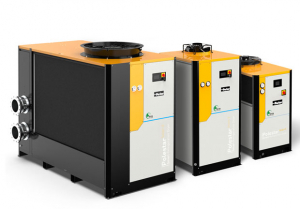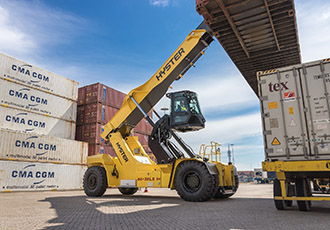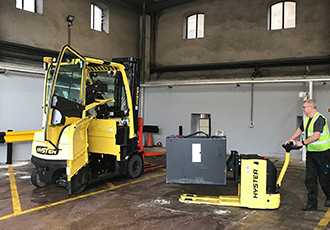Braking Ideas For Wind Turbines
26th August 2010
Source:
Altra Industrial Motion

With requirements for clean energy placing the focus ever more strongly on wind turbines, getting the greatest possible output from a given installation is becoming more and more important. The amount of useful energy that a turbine can extract from the wind is proportional to the total area which the blades of the turbine will sweep. It is no surprise, then, to see that wind turbine structures are growing steadily bigger. But this places ever greater loads and stresses on the associated mechanical power transmission components in general, and on the brakes in particular.
Brakes for wind turbines call for higher cycle rates, higher loads, greater reliability and often in more compact packages than those on conventional factory equipment. Consider, too, that they must operate automatically in installations that are largely unmanned, often in remote areas that makes access for maintenance both difficult and costly. They must operate reliably in some of the most challenging environmental conditions – often subject to extremes of humidity or temperature. They must ensure absolute reliability when located in areas as diverse as offshore sites in salt atmospheres or desert sites subject to dust.
Brakes are key at several locations on a wind turbine. Regardless of size, a turbine structure will require rotor brakes, yaw control brakes and blade pitch control brakes – all with specific design considerations.
Rotor brakes control overspeed, and provide parking and emergency braking. Altra Industrial Motion company Twiflex has considerable expertise in the supply of rotor brakes for the very largest wind turbines. Sales and Marketing Director Jon Cooksley comments: “Almost all wind turbine rotor brakes are of the fail-to-safe design, being spring-applied and hydraulically released. They incorporate powerful springs which directly, or through an independently mounted thruster, apply force to press each brake liner against a disc. The brakes are released by compressing the springs with high pressure hydraulic oil supplied from a power pack.”
Rotor brakes can be mounted on the low speed rotor shaft, on the high-speed generator shaft, and in some cases on both shafts. Low speed shaft braking is relatively straightforward in that a large disc brake, with a large friction lining area, is easy to accommodate. But wind turbine applications require a very high braking torque. So, generally speaking, the most cost-effective position for the brake is on the high-speed shaft between the gearbox and the generator, where the high ratio of the gearbox means a large reduction in output torque.
However, placing the brake on the high speed shaft typically means that it will be operating within a more limited space envelope. The energy which must be dissipated is the same wherever the brake is placed, meaning the total linking area must be the same. Also, the brake pad area must be sufficient to dissipate the heat generated during braking – particularly during emergency stops. Speed and available space quickly become limiting factors with regard to the maximum disc diameter, impacting on brake selection.
A further consideration regarding brake position is the possibility of gear tooth damage. If brakes are installed on the gearbox output shaft and the turbine is stationary, gusts are likely to cause the rotor to transmit a rocking motion within the backlash of the input and output gears. Without forced lubrication between the mating teeth this effect could ultimately result in fretting and expensive gear damage.
The braking torque level for rotor brakes is a crucial consideration that must be calculated during initial stages of a brake design. The maximum permissible braking torque on the rotor shaft is usually imposed by the blades, or their anchorage to the gearbox input shaft. On the other hand, high-speed shaft braking is usually related to the maximum permissible gear-tooth loading. A minimum level of braking torque also exists, below which the variable nature of the frictional forces under different operating conditions could place the turbine rotors at risk. It is therefore important to allow an adequate window of safety, or service factor, to ensure that the brakes will always operate effectively and under all climatic conditions.
Factors which impact on the calculations include rotor inertia, aerodynamic torque, rotor speed, the composition of the brake liner material and the thermal properties of the disc. But there are other factors to consider, too, such as the effects of dirt on braking surfaces, condensation, oil on the braking surfaces, rubbing speed and pressure, and wear debris on the surface linings. Because wind turbines operate unmanned, it is not possible to monitor all of these conditions, so an allowance must be made when calculating a safe torque level.
Brakes for Yaw Control
Under normal operational conditions, a horizontal axis wind turbine can be stopped by moving the blades out of the wind. Yaw brakes provide an effective means of smoothly controlling a wind turbine nacelle as it “rotates up wind”, or yaws. They are usually installed as drag brakes and operate by controlling back pressure, which in turn controls the degree of spring force and therefore braking torques.
The process begins when an anemometer signals a change in wind direction, so starting up the motor driving the gear ring on the yawing system. The motor is subsequently stopped by a further signal when the yaw mechanism reaches the optimum up wind position and the nacelle stops. Edouard Haffner, responsible for New Market Development in Europe for Altra comments: “Varying wind strengths cause varying motor loading and so impact on the accuracy of the nacelle stop relative to the change in wind direction. Motor load can be effectively controlled regardless of wind strength by installing a permanently applied, electromechanically released brake on the gear-ring face and varying its drag from the signal actuated by the rise or fall in motor current.”
Typically, there are four to eight yaw motors per turbine. The brakes usually mount to the back end of the drive motors and are commonly positioned on the underside of the yaw gear ring. This ensures accurate nacelle positioning and best operating efficiency. The design eliminates potential damage from erratic movement with gear backlash, and the brake is an effective clamp to lock the mechanism in position.
Wind-turbine engineers agree that a mechanical disc brake is the best solution in terms of reliability, simplicity of manufacture, ease of servicing and initial cost. Disc brakes are renowned for their excellent performance in hostile environments and require little physical space relative to the braking force they provide.
Blade Pitch Control Braking Considerations
Large horizontal axis wind turbines “pitch” or angle their rotor blades for best efficiency. The rotor blades are also pitched or feathered to minimise rotation in high winds and for turbine maintenance. Mr Haffner continues: “Pitch drives can be driven electrically or hydraulically; electric is most common, which lends itself to a cleaner, more compact design. In addition, the electric drive is more accurate and can be easily programmed to meet a variety of application variables. In either case, a power-off holding brake built into the drive serves as an added safety feature, as well as for dynamic braking in emergency pitch conditions.”
The general layout of an electric pitch drive includes an electric motor (AC, DC, or servo), a position sensor (encoder or resolver), and a power-off holding brake. Control logic releases the brake, drives the motor, senses the position, stops the pitch operation, and engages the brake to hold the blades in a predetermined position. The motor drives a large ring gear integral to each blade, typically with a gear ratio in the 1,000:1 range.
Brakes are key at several locations on a wind turbine. Regardless of size, a turbine structure will require rotor brakes, yaw control brakes and blade pitch control brakes – all with specific design considerations.
Rotor brakes control overspeed, and provide parking and emergency braking. Altra Industrial Motion company Twiflex has considerable expertise in the supply of rotor brakes for the very largest wind turbines. Sales and Marketing Director Jon Cooksley comments: “Almost all wind turbine rotor brakes are of the fail-to-safe design, being spring-applied and hydraulically released. They incorporate powerful springs which directly, or through an independently mounted thruster, apply force to press each brake liner against a disc. The brakes are released by compressing the springs with high pressure hydraulic oil supplied from a power pack.”
Rotor brakes can be mounted on the low speed rotor shaft, on the high-speed generator shaft, and in some cases on both shafts. Low speed shaft braking is relatively straightforward in that a large disc brake, with a large friction lining area, is easy to accommodate. But wind turbine applications require a very high braking torque. So, generally speaking, the most cost-effective position for the brake is on the high-speed shaft between the gearbox and the generator, where the high ratio of the gearbox means a large reduction in output torque.
However, placing the brake on the high speed shaft typically means that it will be operating within a more limited space envelope. The energy which must be dissipated is the same wherever the brake is placed, meaning the total linking area must be the same. Also, the brake pad area must be sufficient to dissipate the heat generated during braking – particularly during emergency stops. Speed and available space quickly become limiting factors with regard to the maximum disc diameter, impacting on brake selection.
A further consideration regarding brake position is the possibility of gear tooth damage. If brakes are installed on the gearbox output shaft and the turbine is stationary, gusts are likely to cause the rotor to transmit a rocking motion within the backlash of the input and output gears. Without forced lubrication between the mating teeth this effect could ultimately result in fretting and expensive gear damage.
The braking torque level for rotor brakes is a crucial consideration that must be calculated during initial stages of a brake design. The maximum permissible braking torque on the rotor shaft is usually imposed by the blades, or their anchorage to the gearbox input shaft. On the other hand, high-speed shaft braking is usually related to the maximum permissible gear-tooth loading. A minimum level of braking torque also exists, below which the variable nature of the frictional forces under different operating conditions could place the turbine rotors at risk. It is therefore important to allow an adequate window of safety, or service factor, to ensure that the brakes will always operate effectively and under all climatic conditions.
Factors which impact on the calculations include rotor inertia, aerodynamic torque, rotor speed, the composition of the brake liner material and the thermal properties of the disc. But there are other factors to consider, too, such as the effects of dirt on braking surfaces, condensation, oil on the braking surfaces, rubbing speed and pressure, and wear debris on the surface linings. Because wind turbines operate unmanned, it is not possible to monitor all of these conditions, so an allowance must be made when calculating a safe torque level.
Brakes for Yaw Control
Under normal operational conditions, a horizontal axis wind turbine can be stopped by moving the blades out of the wind. Yaw brakes provide an effective means of smoothly controlling a wind turbine nacelle as it “rotates up wind”, or yaws. They are usually installed as drag brakes and operate by controlling back pressure, which in turn controls the degree of spring force and therefore braking torques.
The process begins when an anemometer signals a change in wind direction, so starting up the motor driving the gear ring on the yawing system. The motor is subsequently stopped by a further signal when the yaw mechanism reaches the optimum up wind position and the nacelle stops. Edouard Haffner, responsible for New Market Development in Europe for Altra comments: “Varying wind strengths cause varying motor loading and so impact on the accuracy of the nacelle stop relative to the change in wind direction. Motor load can be effectively controlled regardless of wind strength by installing a permanently applied, electromechanically released brake on the gear-ring face and varying its drag from the signal actuated by the rise or fall in motor current.”
Typically, there are four to eight yaw motors per turbine. The brakes usually mount to the back end of the drive motors and are commonly positioned on the underside of the yaw gear ring. This ensures accurate nacelle positioning and best operating efficiency. The design eliminates potential damage from erratic movement with gear backlash, and the brake is an effective clamp to lock the mechanism in position.
Wind-turbine engineers agree that a mechanical disc brake is the best solution in terms of reliability, simplicity of manufacture, ease of servicing and initial cost. Disc brakes are renowned for their excellent performance in hostile environments and require little physical space relative to the braking force they provide.
Blade Pitch Control Braking Considerations
Large horizontal axis wind turbines “pitch” or angle their rotor blades for best efficiency. The rotor blades are also pitched or feathered to minimise rotation in high winds and for turbine maintenance. Mr Haffner continues: “Pitch drives can be driven electrically or hydraulically; electric is most common, which lends itself to a cleaner, more compact design. In addition, the electric drive is more accurate and can be easily programmed to meet a variety of application variables. In either case, a power-off holding brake built into the drive serves as an added safety feature, as well as for dynamic braking in emergency pitch conditions.”
The general layout of an electric pitch drive includes an electric motor (AC, DC, or servo), a position sensor (encoder or resolver), and a power-off holding brake. Control logic releases the brake, drives the motor, senses the position, stops the pitch operation, and engages the brake to hold the blades in a predetermined position. The motor drives a large ring gear integral to each blade, typically with a gear ratio in the 1,000:1 range.
Similar articles
More from Altra Industrial Motion
- Innovation corner illustrates problem solving solutions 8th November 2019
- Taking crane braking to new heights 15th April 2019
- Solutions for challenging applications at SPS Drives 29th October 2018
- Stainless drives take over at fish processing plant 4th April 2018




.jpg)







Write a comment
No comments